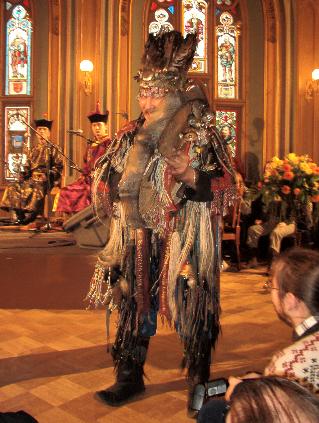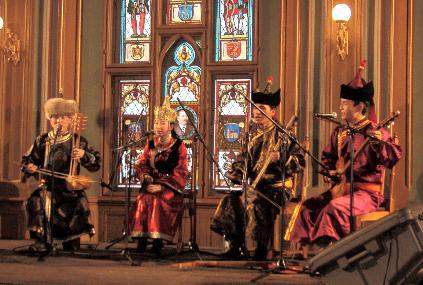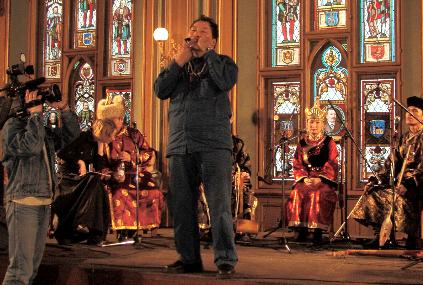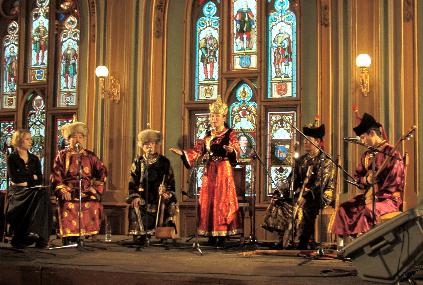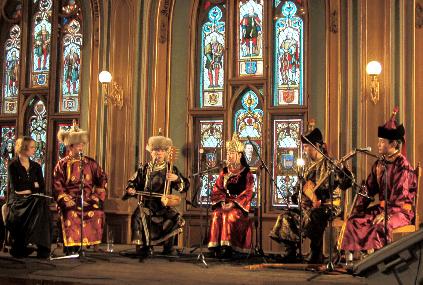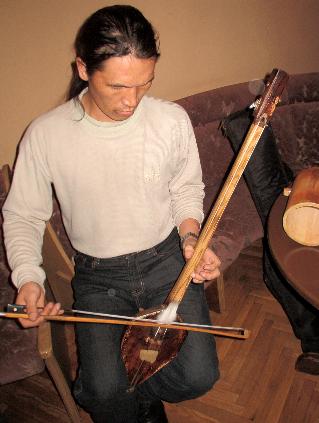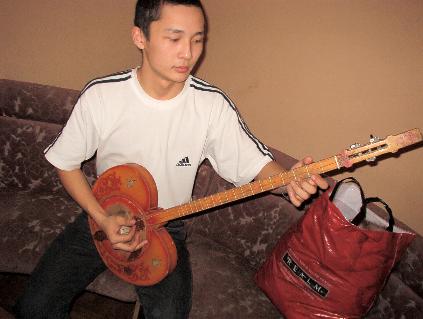|
|
|
|
|
Folklore groups
Instruments Activities About us |
|
|
|
Calendar
Regular Reportings Education |
|
|
|
Support
Fonts Mpeg3 Links Addresses Statistics Guestbook |
|
|
|
You are visitor of folklora.lt and visitor of this page. |
|
Concert of the group "Ay Kherel", Riga,
In the middle of January within the festival Riga music in Riga
performed Tuvinian ensemble Ay Kherel (Moonbeam), and
we have visited their concert in the Riga Small Guild.
At the beginning of the concert Andris Kapusts has congratulated the festival
with the first anniversary and presented a globe to its main organizer Peteris
Selga. After that ethnomusicologist Boris Avramets has told about a necessity
of a personal contact for hearing folk music, about the small population (about 200
thousand), but the large popularity of Tuvinians, and about techniques of a
throat singing.
The leader of the group Vladimir Soyan has told some introduction
words and then has invited shaman Lazo Mongush to consecrate the hall.
First the shaman has told about his craft - his regimentals weighs
approximately 30-40 kg; shamans can gear up they force both from a
concourse of people, by walking on live coals, cuting or burning of
themselfs. The last way the shaman shown to spectators: he walked thrue
the hall with a burning junipers' bunch. Seems (if it was not an optical
illusion), that time from time he truly allowed the flame to lick
his hands. After that the shaman began to conjure: to beat a timbrel,
to move, to turn and to sing.
The group Ay Kherel started they performance with a Buddhist lamas'
pray. It was the sole song without an instrumental accompaniment, that, obviously,
depends of the religious importance and of ancientity of the melody. Interestingly,
that Estonians has similar folk melodies.
In continuation the ensemble has played 20 more songs. By contents its
was about nature (rivers, mountains), native places, thirst of freedom,
shepherds, horses and even about a tractor operator; also - one chaffing and
one jokes' song. From a musical point of view were felt elements of Chinese,
Mongolian and Turki' music (Tuvinians are Turki by language and Buddhists
by religion); certainly, basically the songs were mixture of the those
influences, though some "pure" specimens came across too. The majority
of songs (excepting the "Chinese-like") were fast and with a pronounced
rhythm, that is an indicative of a large influence of a modern music on
arrangements of the ensemble. It is interesting, that this rhythm was created
by string instruments, without drums. The modernity of arrangements was
confirmed by second voices too - its was created in classical harmonies.
Actually, fully traditional was only several songs - the already mentioned pray,
examples of throat singing (the executors have shown 5 of 7 kinds, widespread in
Tuva), and performances of the shaman. The song singed "under a phonogram" by Lilia Soyan, a daughter
of the group's leader, stired up a misunderstanding in listeners who have come
to an "alive" music. In turn, the biggest applauses was after
Belik's Elikben's throat singing in accompaniment of bizanch (an instument, made
from a birch tree and a goat's leather; horsehairs of bow of it are plaited
between strings). A strong impression has made the low throat singing of Timur
Karasal. String playing of all the three lads was dexterous and free, with
interesting improvisations.
The ensemble looks as a well considered and realized enterprise, instead of a
group of persons who shares the same views. The leader sings poorly, bu he is
a good organizer and story-teller. He has involved three gifted lads, which
sing and play very well, and, as a matter of fact, are an artistical pith
of the collective; the family of the leader without those lads would be nothing,
but lads without the family could performe in a good quality. Certainly,
those lads could not to make a such good management as it does Vladimir Soyan.
The daughter of the leader Lilia sings well, however, her lobbying from the
part of the father is too striking. The wife of the leader travels with the
group and is called a "manager", though looks, that all managing things does
the leader itself.
The concert was interesting, however the main impression was that it's
program is oriented to listeners who are not connected to folk music
(for example, Western tourists). Eastern European folk music lovers
with much more pleasure would listen a pure, not altered Tuvinian folk music. Songs' recordings from this activity:
Article: Ansis Ataols Bērziņš, 27 February 2003 |
|
Questions, comments and suggestions are welcome to ansis_N@N_folklora.lt This page is created with support of SFL, Latnet and Lanet. |
|
03 September 2018 |

